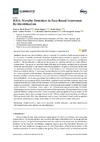Identificador persistente para citar o vincular este elemento:
https://accedacris.ulpgc.es/jspui/handle/10553/60100
| Título: | ILRA: novelty detection in face-based intervener re-identification | Autores/as: | Marin-Reyes, Pedro A. Irigoien, Itziar Sierra, Basilio Lorenzo-Navarro, Javier Castrillon-Santana, Modesto Arenas, Concepcion |
Clasificación UNESCO: | 120304 Inteligencia artificial | Palabras clave: | Re-identification Open world scenario Novelty detection One-class classification ILR transformation, et al. |
Fecha de publicación: | 2019 | Proyectos: | Identificación Automática de Oradores en Sesiones Parlamentarias Usando Características Audiovisuales. | Publicación seriada: | Symmetry | Resumen: | Transparency laws facilitate citizens to monitor the activities of political representatives. In this sense, automatic or manual diarization of parliamentary sessions is required, the latter being time consuming. In the present work, this problem is addressed as a person re-identification problem. Re-identification is defined as the process of matching individuals under different camera views. This paper, in particular, deals with open world person re-identification scenarios, where the captured probe in one camera is not always present in the gallery collected in another one, i.e., determining whether the probe belongs to a novel identity or not. This procedure is mandatory before matching the identity. In most cases, novelty detection is tackled applying a threshold founded in a linear separation of the identities. We propose a threshold-less approach to solve the novelty detection problem, which is based on a one-class classifier and therefore it does not need any user defined threshold. Unlike other approaches that combine audio-visual features, an Isometric LogRatio transformation of a posteriori (ILRA) probabilities is applied to local and deep computed descriptors extracted from the face, which exhibits symmetry and can be exploited in the re-identification process unlike audio streams. These features are used to train the one-class classifier to detect the novelty of the individual. The proposal is evaluated in real parliamentary session recordings that exhibit challenging variations in terms of pose and location of the interveners. The experimental evaluation explores different configuration sets where our system achieves significant improvement on the given scenario, obtaining an average F measure of 71.29% for online analyzed videos. In addition, ILRA performs better than face descriptors used in recent face-based closed world recognition approaches, achieving an average improvement of 1.6% with respect to a deep descriptor. | URI: | https://accedacris.ulpgc.es/handle/10553/60100 | ISSN: | 2073-8994 | DOI: | 10.3390/sym11091154 | Fuente: | Symmetry[ISSN 2073-8994],v. 11 (9), 1154 |
| Colección: | Artículos |
Visitas
290
actualizado el 01-jun-2024
Descargas
134
actualizado el 01-jun-2024
Google ScholarTM
Verifica
Altmetric
Comparte
Exporta metadatos
Los elementos en ULPGC accedaCRIS están protegidos por derechos de autor con todos los derechos reservados, a menos que se indique lo contrario.
